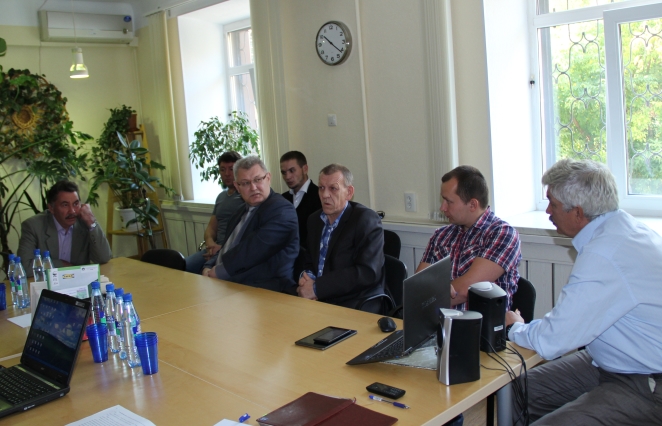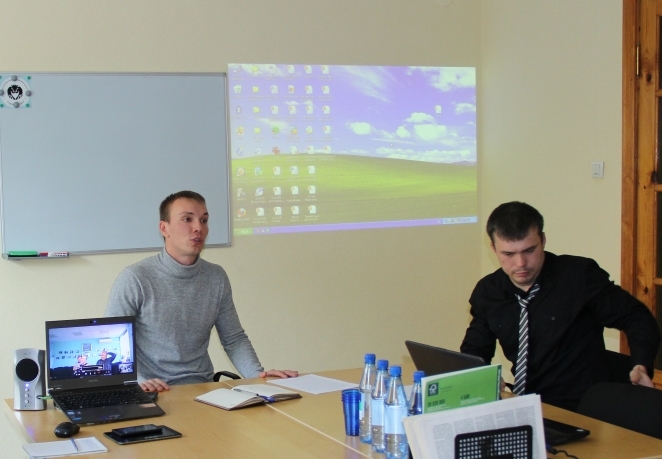Salmon Monitoring: Theory and Practice
On the 24th of September, the Silver Taiga Foundation office hosted the seminar “Atlantic salmon monitoring experience”, aimed not only at the information exchange on the history and peculiarities of this species monitoring, but also an informational and methodological preparation of the potential participants of the annual monitoring expeditions carried out within the framework of the Model River Mezen project.
The seminar has been attended by the representatives of the Institute of Biology, Komi Scientific Centre, Ural Division of Russian Academy of Science, Northern branch of the Federal State Unitary Enterprise “PINRO”, Ministry of Agriculture and Food of the Republic of Komi, Department of state control, supervision and protection of aquatic bioresources of the Komi Republic, FSBI “Komirybvod”, Republican Centre of Provision of Functioning of Specially Protected Natural Areas under the Ministry of Nature of the Komi Republic, and Silver Taiga Foundation.
In spite of the different level of the participants’ preparation on the seminar topic, the information provided during the reports – from the issues related to the general biology of the Atlantic salmon living in the Mezen to the comparative analysis of different research methods – was interesting and useful for everyone.
A great advantage of this seminar was the fact that the organizers managed to engage the Head of the inland waters biological resources laboratory of the Northern branch of FSUI “PINRO” Igor Ivanovich Studyonov to participate in the meeting. He has made a report on the history of the multiyear observation over the salmon in the Mezen and Pechora rivers. The fact is that, according to the current legislation, the monitoring of salmon, as an anadromous species, is under federal jurisdiction and it is PINRO – corporate institute of the Russian Federal Agency for Fisheries – the monitoring is assigned to. Collaboration and coordinated actions with the specialists from this institute are critically important for the Model River Mezen project participants.
It should be noted that the seminar conducted within the framework of the project is not the first interregional event related to the Atlantic salmon conservation. After a number of joint meetings with participation of both regions – Komi and Arkhangelsk – this year the development of an interregional program on conservation of the Mezen salmon has been started. The research work on the assessment of the current state and trends in the Atlantic salmon population development in the Mezen, including various monitoring methods, is one of the areas covered by this program. And such work has already been started. In particular, in June of this year SevPINRO (Northern branch of the Polar Research Institute of Marine Fisheries and Oceanography) specialists maintained the records on the young salmon running to see (smolt) on the river Mezen and its main tributary, the river Vashka, near the village Nisogora in the Leshukonsky district of the Arkhangelsk region. Based on the results of these works, the first general conclusions on the fullness of the spawning grounds and migration dynamics can be made. Unfortunately, last summer the Komi Republic didn’t take part in the funding of these works, unlike the Arkhangelsk region. However, it is planned to carry out a similar accounting on the boarder of the Komi and Arkhangelsk region in parallel to the works in the Leshukonsky district in 2015. It would then be possible to evaluate a reproduction potential of the salmon both on the Mezen and Vashka.
Besides, an autumn redds accounting on the spawning grounds of the upper reaches of the Mezen and its three tributaries have already been conducted by the interested participants of the Model River Mezen project for the forth year. The ichthyologist of the FSBI “Komirybvod” Alexey Politov, annually participating in these autumn expeditions, talked about this practice and peculiarities of the salmon monitoring on the spawning grounds at the seminar. According to a number of experts, this method – redds accounting – is good for the assessment of the quality and fullness of the spawning grounds, whereas it’s better to use other methods for accounting of the salmon population size. During the discussion, the participants agreed that it is necessary to combine all methods of accounting and monitoring in order to get an objective general overview of the population state, which is possible only through the cooperation of the specialists of two regions.
In addition to the discussion of the advantages and disadvantages of various monitoring methods, the seminar participants exchanged opinions on the feasibility of fish breeding plants creation, which has recently been increasingly announced in the mass media.
The Foundation Director Yury Pautov asked the professionals whether an artificial salmon reproduction was effective and reasonable.
– Can any of you give an example of a fish plant having restored the salmon population in some river? – I.I. Studyonov answered a question with a question. – The aim of the fish breeding plants is not the population restoration but fishing-out, profit-making. They have other tasks. Though, if it’s done properly, considering all necessary conditions and species peculiarities, in small rivers, probably, it’s real to achieve the restoration.
To follow up the theoretical seminar discussion, last Sunday a group consisting of the ecologists – Silver Taiga Foundation employees, FSBI “Komirybvod” ichthyologists, representatives of the Department of state control, supervision and protection of aquatic bioresources, and local community “Udorachi” went to the Udora district to carry out an annual monitoring in the upper reaches of the Mezen and its tributaries. As in past years, they will also monitor and analyze the poaching situation. We will surely provide the information about the results of this expedition in the next news coverage.
Valentina Semyashkina
Photo is made by Sergey Davydov
Translated by Irina Sokolova



